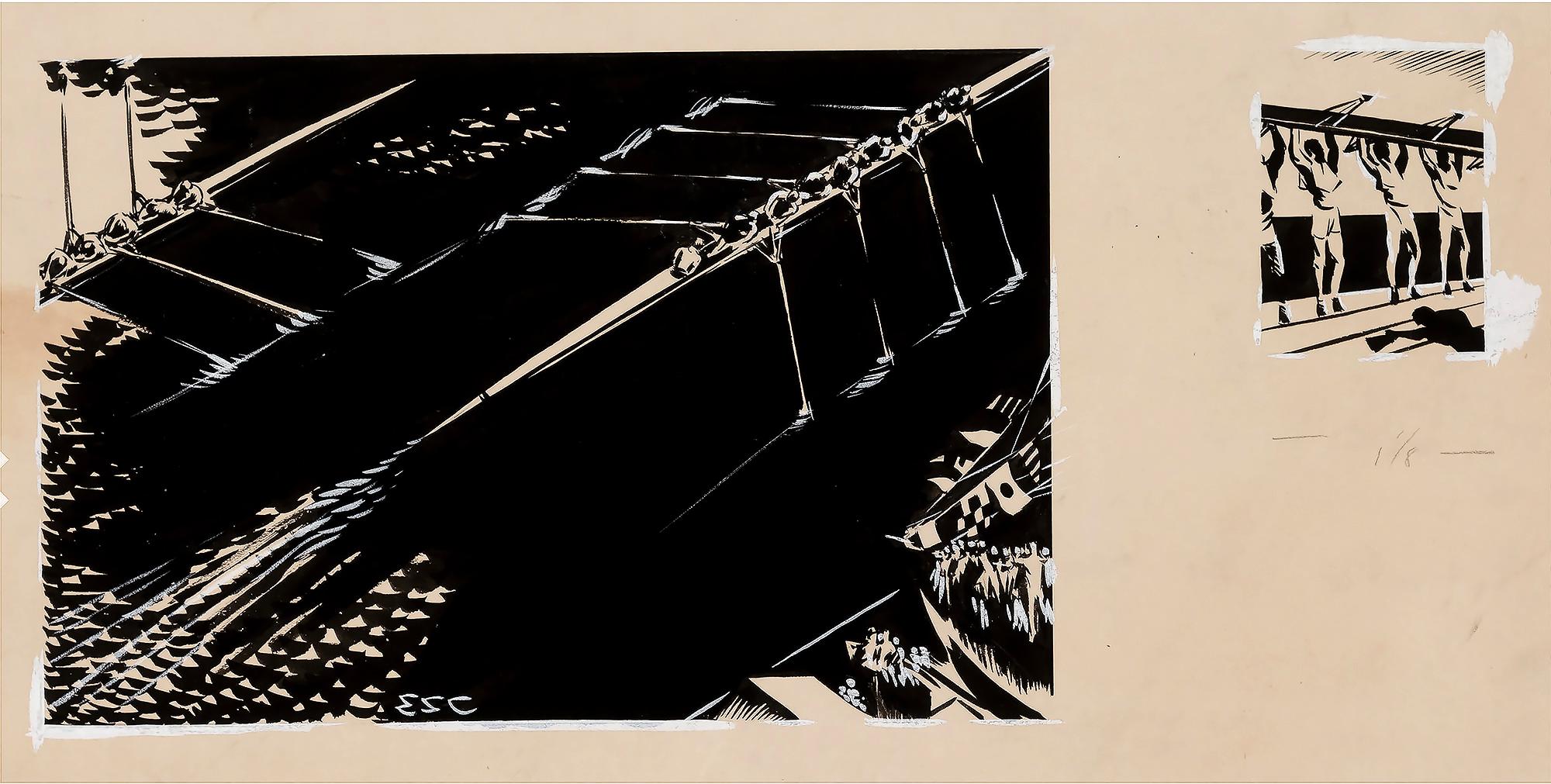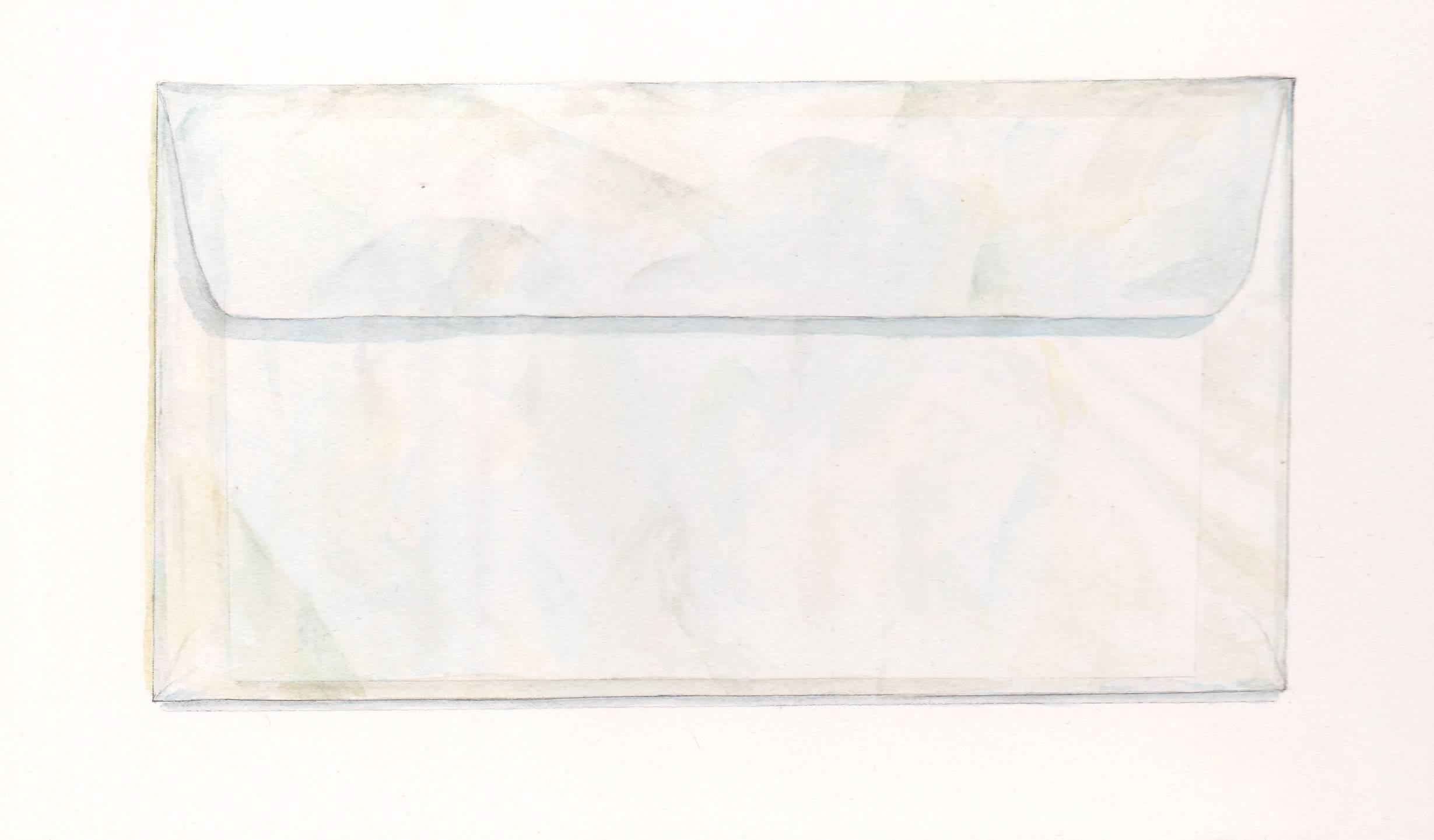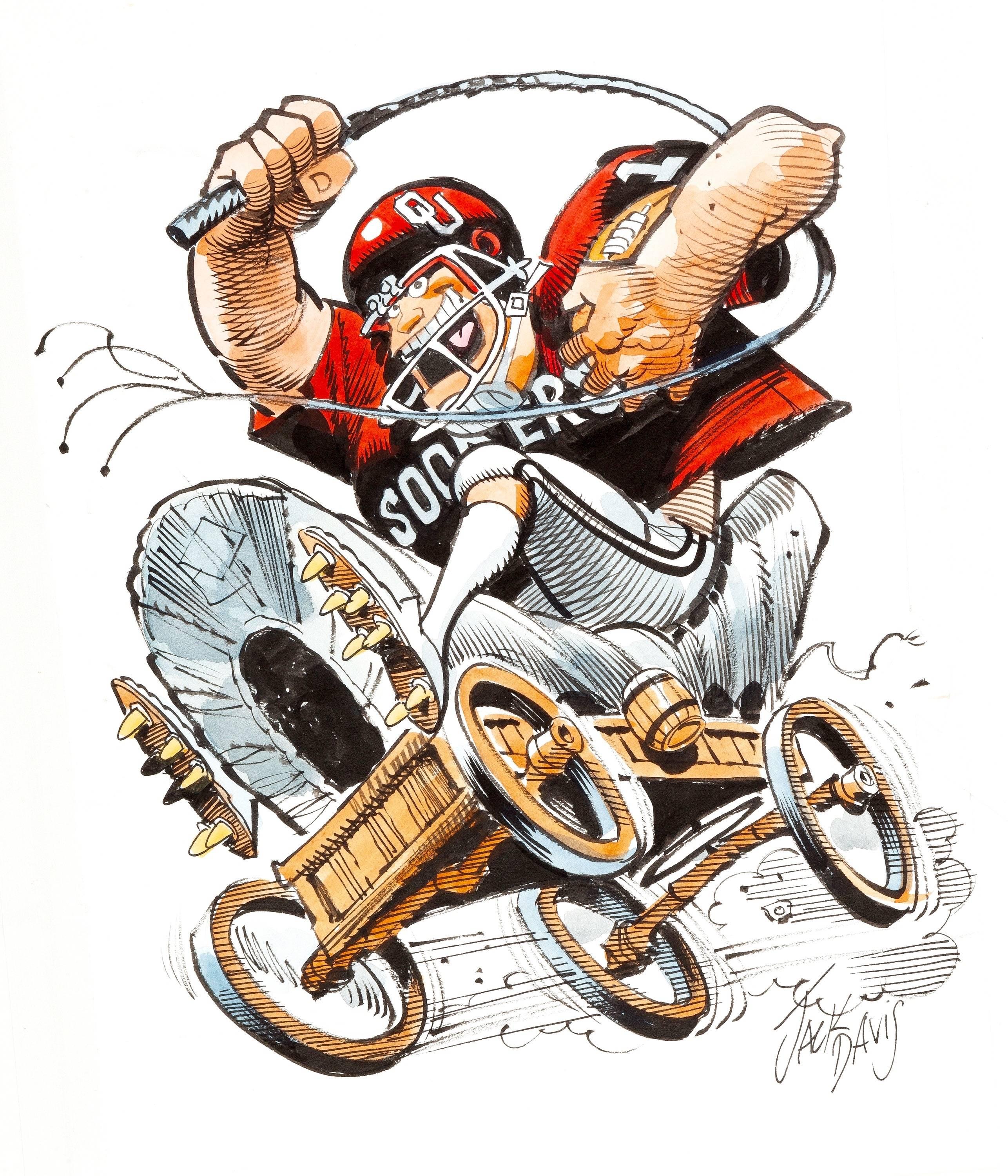Items Similar to Caricature Cover Design of "Ray Milland, Globe-Trotting Sleuth"
Want more images or videos?
Request additional images or videos from the seller
1 of 2
George WachsteterCaricature Cover Design of "Ray Milland, Globe-Trotting Sleuth"1959
1959
About the Item
Medium: Ink and Pencil on Illustration Board
Signature: Signed Lower Left
Ink and Pencil on Illustration Board with Color Overlay Caricature Cover Design of `Ray Milland, Globe-Trotting Sleuth` for the CBS-TV Show `Markham` that had 59 episodes from May 2, 1959 to Sept 15, 1960, this art appeared on the cover for the Sunday, May 17, 1959 issue of the New York Journal American Pictorial Magazine & TView Section, 14" x 9 1/2" image on 22" x 14" board, good condition, minor soiling. Includes copies of the original magazine cover.
- Creator:George Wachsteter (1911 - 2004)
- Creation Year:1959
- Dimensions:Height: 14 in (35.56 cm)Width: 9.5 in (24.13 cm)
- Medium:
- Period:
- Condition:
- Gallery Location:Fort Washington, PA
- Reference Number:1stDibs: LU38436159602
About the Seller
5.0
Recognized Seller
These prestigious sellers are industry leaders and represent the highest echelon for item quality and design.
Gold Seller
These expertly vetted sellers are highly rated and consistently exceed customer expectations.
Established in 1995
1stDibs seller since 2016
107 sales on 1stDibs
Typical response time: 5 hours
- ShippingRetrieving quote...Ships From: Fort Washington, PA
- Return PolicyA return for this item may be initiated within 14 days of delivery.
More From This SellerView All
- Dallas Cowboys Football IllustrationBy Jack DavisLocated in Fort Washington, PADate: 1990 Medium: Mixed Media over Graphite on Illustration Board Dimensions: 10.00" x 9.50" Jack Davis (attributed) Dallas Cowboys Football Illustration Original Art (Hot Shot...Category
1990s Mixed Media
MaterialsMixed Media, Watercolor, Illustration Board, Graphite
- Oklahoma SoonersBy Jack DavisLocated in Fort Washington, PADate: 1990 Medium: Mixed Media over Graphite on Paper affixed Illustration Board Dimensions: 8.50" x 11.50" Signature: Signed Lower Right Jack Davis Oklahoma Sooners College Football...Category
1990s Figurative Drawings and Watercolors
MaterialsIllustration Board, Mixed Media, Graphite
- Broadway Show, "The Assassin, " 1945By George WachsteterLocated in Fort Washington, PAMedium: Pen and Ink on Illustration Board Signature: Signed Upper Right Caricature by George Wachsteter (1911-2004) of Broadway show `The Assassin with Frank Sundstrom and Lesley Woods, at the National Theatre. Written by Irwin Shaw, directed by Martin Gabel, directed by Boris Aronson...Category
1940s Figurative Drawings and Watercolors
MaterialsInk, Illustration Board, Pen
- Don McNeill for "TV Club"By George WachsteterLocated in Fort Washington, PAMedium: Pen and Ink on Illustration Board Signature: Signed Lower Right Caricature by George Wachsteter (1911-2004) of Don McNeill for the 1950-51 ABC-TV series `TV Club` (aka `Don McNeill`s TV Club), a one-hour prime time...Category
1950s Figurative Drawings and Watercolors
MaterialsIllustration Board, Ink, Pen
- "All in Good Time"By George WachsteterLocated in Fort Washington, PAMedium: Pen and Ink on Illustration Board Signature: Signed Lower Left Caricature by George Wachsteter (1911-2004) for 1965 Broadway Comedy `All in Good Time` starring Donald Wolfit, Hazel Douglas, John Sharp...Category
1960s Figurative Drawings and Watercolors
MaterialsIllustration Board, Ink, Pen
- 1958 Broadway Musical Revue, "International Soiree"By George WachsteterLocated in Fort Washington, PAMedium: Pen and Ink on Illustration Board Signature: Signed Lower Right Caricature by George Wachsteter (1911-2004) for 1958 Broadway Musical Revue `International Soiree`, starring French singing star Patachou, Hiram Sherman. Featuring Spanish flamenco dancers Caracolillo and Maria Rosa, Belgian pantomimist Cornelis and George La Faye`s French puppets...Category
1950s Figurative Drawings and Watercolors
MaterialsIllustration Board, Ink, Pen
You May Also Like
- Rowing Sculling Team Regatta, Life Magazine - African American IllustratorBy E. Simms CampbellLocated in Miami, FLE. Simms Campbell was the first African-American illustrator/ cartoonist published in nationally distributed, slick magazines, he created Esky, the familiar pop-eyed mascot of Esquire. This early work of 1930 was done on assignment for an interior page of Life Magazine. It features two Rowing teams engaged in spirited competition with cheering onlookers. This is a highly stylized black-and-white illustration and is masterfully executed. The work is composed of two illustrations, 6 x 9 inches and 2-3/4 x 2 inches respectively. It is initialed center bottow ESC. unframed Campbell left the University of Chicago and transferred to and received his degree from the Chicago Art Institute.[3] Professional career During a job as a railroad dining-car waiter, Campbell sometimes drew caricatures of the train passengers, and one of those, impressed by Campbell's talent, gave him a job in a St. Louis art studio, Triad Studios. He spent two years at Triad Studios before moving to New York City in 1929. A month afterward, he found work with the small advertising firm, Munig Studios, and began taking classes at the National Academy of Design.During this time, he contributed to various magazines, notably Life, & Judge Following the suggestion of cartoonist Russell Patterson to focus on good girl art, Campbell created his "Harem Girls", a series of watercolor cartoons that attracted attention in the first issue of Esquire, debuting in 1933. Campbell's artwork was in almost every issue of Esquire from 1933 to 1958 and he was the creator of its continuing mascot, the cartoon character in a silk top hat. He also contributed to The Chicagoan, Cosmopolitan, Ebony, The New Yorker, Playboy, Opportunity: A Journal of Negro Life, Pictorial Review, and Redbook. His commercial artwork for advertising included illustrations for Barbasol, Springmaid, and Hart Schaffner...Category
1930s Figurative Drawings and Watercolors
MaterialsGouache, Pencil, Ink, Illustration Board
- Margot Glass, Long Glassine Envelope, Watercolor and pencil still life, 2016By Margot GlassLocated in New York, NYMargot Glass explores the fragility of communication, and people’s natural drive to find narrative in even the most ordinary of objects. In her Envelopes series, Glass works in water...Category
2010s Contemporary Figurative Drawings and Watercolors
MaterialsPencil, Illustration Board, Watercolor
- Nightie Night - 5"x9", Small Framed Artwork, White, Beige, FeminineBy Andrea Stajan-FerkulLocated in Mississauga, OntarioA soft neutral palette used in this artwork adds to the graceful, feminine quality of the subject matter. Focus is placed on the blending of delicate detail and expressive brush wor...Category
2010s Contemporary Figurative Drawings and Watercolors
MaterialsAcrylic, Pencil, Illustration Board
- Whimsical Fishing Illustration Cartoon 1938 Mt Tremblant Ski Lodge William SteigBy William Steig (b.1907)Located in Surfside, FLLighthearted Illustration of Outdoor Pursuits This one of a fisherman signed "W. Steig" Provenance: from Mrs. Joseph B. Ryan, Commissioned by Joe Ryan for the bar at his ski resort, Mount Tremblant Lodge, in 1938. Mont Tremblant, P.Q., Canada Watercolor and ink on illustration board, sights sizes 8 1/2 x 16 1/2 in., framed. In 1938 Joe Ryan, described as a millionaire from Philadelphia, bushwhacked his way to the summit of Mont Tremblant and was inspired to create a world class ski resort at the site. In 1939 he opened the Mont Tremblant Lodge, which remains part of the Pedestrian Village today. This original illustration is on Whatman Illustration board. the board measures 14 X 22 inches. label from McClees Galleries, Philadelphia, on the frame backing paper. William Steig, 1907 – 2003 was an American cartoonist, sculptor, and, in his later life, an illustrator and writer of children's books. Best known for the picture books Sylvester and the Magic Pebble, Abel's Island, and Doctor De Soto, he was also the creator of Shrek!, which inspired the film series of the same name. He was the U.S. nominee for both of the biennial, international Hans Christian Andersen Awards, as a children's book illustrator in 1982 and a writer in 1988. Steig was born in Brooklyn, New York in 1907, and grew up in the Bronx. His parents were Polish-Jewish immigrants from Austria, both socialists. His father, Joseph Steig, was a house painter, and his mother, Laura Ebel Steig, was a seamstress who encouraged his artistic leanings. As a child, he dabbled in painting and was an avid reader of literature. Among other works, he was said to have been especially fascinated by Pinocchio.He graduated from Townsend Harris High School at 15 but never completed college, though he attended three, spending two years at City College of New York, three years at the National Academy of Design and a mere five days at the Yale School of Fine Arts before dropping out of each. Hailed as the "King of Cartoons" Steig began drawing illustrations and cartoons for The New Yorker in 1930, producing more than 2,600 drawings and 117 covers for the magazine. Steig, later, when he was 61, began writing children's books. In 1968, he wrote his first children's book. He excelled here as well, and his third book, Sylvester and the Magic Pebble (1969), won the Caldecott Medal. He went on to write more than 30 children's books, including the Doctor DeSoto series, and he continued to write into his nineties. Among his other well-known works, the picture book Shrek! (1990) formed the basis for the DreamWorks Animation film Shrek (2001). After the release of Shrek 2 in 2004, Steig became the first sole-creator of an animated movie franchise that went on to generate over $1 billion from theatrical and ancillary markets after only one sequel. Along with Maurice Sendak, Saul Steinberg, Ludwig Bemelmans and Laurent de Brunhofff his is one of those rare cartoonist whose works form part of our collective cultural heritage. In 1984, Steig's film adaptation of Doctor DeSoto directed by Michael Sporn was nominated for the Academy Award for Best Animated Short Film. As one of the most admired cartoonists of all time, Steig spent seven decades drawing for the New Yorker magazine. He touched generations of readers with his tongue–in–cheek pen–and–ink drawings, which often expressed states of mind like shame, embarrassment or anger. Later in life, Steig turned to children's books, working as both a writer and illustrator. Steig's children's books were also wildly popular because of the crazy, complicated language he used—words like lunatic, palsied, sequestration, and cleave. Kids love the sound of those words even if they do not quite understand the meaning. Steig's descriptions were also clever. He once described a beached whale as "breaded with sand." Throughout the course of his career, Steig compiled his cartoons and drawings into books. Some of them were published first in the New Yorker. Others were deemed too dark to be printed there. Most of these collections centered on the cold, dark psychoanalytical truth about relationships. They featured husbands and wives fighting and parents snapping at their kids. His first adult book, Man About Town, was published in 1932, followed by About People, published in 1939, which focused on social outsiders. Sick of Each Other, published in 2000, included a drawing depicting a wife holding her husband at gunpoint, saying, "Say you adore me." According to the Los Angeles Times, fellow New Yorker artist...Category
1930s American Modern Figurative Drawings and Watercolors
MaterialsIndia Ink, Watercolor, Illustration Board
- Whimsical Illustration "Snow" Cartoon, 1938 Mt Tremblant Ski Lodge William SteigBy William Steig (b.1907)Located in Surfside, FLLighthearted Illustration of Outdoor Pursuits This one being cross country Snow Shoes signed "W. Steig" Provenance: from Mrs. Joseph B. Ryan, Commissioned by ...Category
1930s American Modern Figurative Drawings and Watercolors
MaterialsIndia Ink, Watercolor, Illustration Board
- Whimsical Illustration Hiking Cartoon, 1938 Mt Tremblant Ski Lodge William SteigBy William Steig (b.1907)Located in Surfside, FLLighthearted Illustration of Outdoor Pursuits This one being cross country hiking signed "W. Steig" Provenance: from Mrs. Joseph B. Ryan, Commissioned by Joe Ryan for the bar at his ski resort, Mount Tremblant Lodge, in 1938. Mont Tremblant, P.Q., Canada Watercolor and ink on illustration board, sights sizes 8 1/2 x 16 1/2 in., framed. In 1938 Joe Ryan, described as a millionaire from Philadelphia, bushwhacked his way to the summit of Mont Tremblant and was inspired to create a world class ski resort at the site. In 1939 he opened the Mont Tremblant Lodge, which remains part of the Pedestrian Village today. This original illustration is on Whatman Illustration board. the board measures 14 X 22 inches. label from McClees Galleries, Philadelphia, on the frame backing paper. William Steig, 1907 – 2003 was an American cartoonist, sculptor, and, in his later life, an illustrator and writer of children's books. Best known for the picture books Sylvester and the Magic Pebble, Abel's Island, and Doctor De Soto, he was also the creator of Shrek!, which inspired the film series of the same name. He was the U.S. nominee for both of the biennial, international Hans Christian Andersen Awards, as a children's book illustrator in 1982 and a writer in 1988. Steig was born in Brooklyn, New York in 1907, and grew up in the Bronx. His parents were Polish-Jewish immigrants from Austria, both socialists. His father, Joseph Steig, was a house painter, and his mother, Laura Ebel Steig, was a seamstress who encouraged his artistic leanings. As a child, he dabbled in painting and was an avid reader of literature. Among other works, he was said to have been especially fascinated by Pinocchio.He graduated from Townsend Harris High School at 15 but never completed college, though he attended three, spending two years at City College of New York, three years at the National Academy of Design and a mere five days at the Yale School of Fine Arts before dropping out of each. Hailed as the "King of Cartoons" Steig began drawing illustrations and cartoons for The New Yorker in 1930, producing more than 2,600 drawings and 117 covers for the magazine. Steig, later, when he was 61, began writing children's books. In 1968, he wrote his first children's book. He excelled here as well, and his third book, Sylvester and the Magic Pebble (1969), won the Caldecott Medal. He went on to write more than 30 children's books, including the Doctor DeSoto series, and he continued to write into his nineties. Among his other well-known works, the picture book Shrek! (1990) formed the basis for the DreamWorks Animation film Shrek (2001). After the release of Shrek 2 in 2004, Steig became the first sole-creator of an animated movie franchise that went on to generate over $1 billion from theatrical and ancillary markets after only one sequel. Along with Maurice Sendak, Saul Steinberg, Ludwig Bemelmans and Laurent de Brunhofff his is one of those rare cartoonist whose works form part of our collective cultural heritage. In 1984, Steig's film adaptation of Doctor DeSoto directed by Michael Sporn was nominated for the Academy Award for Best Animated Short Film. As one of the most admired cartoonists of all time, Steig spent seven decades drawing for the New Yorker magazine. He touched generations of readers with his tongue–in–cheek pen–and–ink drawings, which often expressed states of mind like shame, embarrassment or anger. Later in life, Steig turned to children's books, working as both a writer and illustrator. Steig's children's books were also wildly popular because of the crazy, complicated language he used—words like lunatic, palsied, sequestration, and cleave. Kids love the sound of those words even if they do not quite understand the meaning. Steig's descriptions were also clever. He once described a beached whale as "breaded with sand." Throughout the course of his career, Steig compiled his cartoons and drawings into books. Some of them were published first in the New Yorker. Others were deemed too dark to be printed there. Most of these collections centered on the cold, dark psychoanalytical truth about relationships. They featured husbands and wives fighting and parents snapping at their kids. His first adult book, Man About Town, was published in 1932, followed by About People, published in 1939, which focused on social outsiders. Sick of Each Other, published in 2000, included a drawing depicting a wife holding her husband at gunpoint, saying, "Say you adore me." According to the Los Angeles Times, fellow New Yorker artist Edward Sorel...Category
1930s Naturalistic Figurative Drawings and Watercolors
MaterialsArchival Ink, Watercolor, Illustration Board
Recently Viewed
View AllMore Ways To Browse
Illustration Cover
Show Globe
Original Magazine Cover
Original Magazine Cover Art
X Ray Sign
Tv Board
Caricature Original
Original Illustration Cover Painting
Tv Cover
Journal Cover
Original Magazine Cover Art Illustration
Magazine Cover 1959
Vintage Cbs
Pencil Globe
Halston House
Jim Thompson Print
Night Galaxy
Jim Thompson Prints





